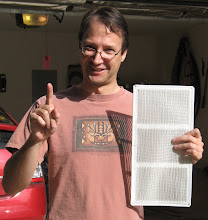
There are a variety of reasons that one might have for deciding to work on home energy efficiency. I will detail some of them below, with some commentary of my own.
First and most important for me to this point in the narrative, is that I'm trained as an engineer, and good engineers cannot stand gross inefficiency in a system that they care to optimize. As I began looking into the apparently "standard" way things were done with my house, I quickly realized that efficiency was probably never a consideration; at least, not any more than the building codes required, which is apparently not much at all. This, plus my experiences in researching transportation efficiency (possibly a topic for another blog!) led me to understand the we have created a lot of the "built" world around us with little consideration of using energy efficiently. Another way of saying this is that we have embedded the assumption of incredibly cheap and plentiful energy into nearly everything we have built. To me, as this embedded assumption becomes less and less true, as it already has and as I predict it will over the next decades, more and more rapid disruptions will be forced upon us as our infrastructure becomes infeasible. I noticed a good bit of this during the oil price shocks of the last couple of years, and oil prices only affect the transportation part of the energy picture. I think it's self-evident that the hardships will be even more severe when the price of non-transportation energy, i.e. electricity, undergoes significant increase.
So how can we protect ourselves against the already noticeable increases in the cost and scarcity of energy? One way, friends, is energy efficiency in all things! There is a cost (monetary, environmental, and in land use) with any form of energy generation. It seems clear that the best thing we can do to help all of the above costs is to use the energy we generate as efficiently as possible, something we are patently not doing right now on a broad scale in this country.
The preceding paragraphs begin to touch on the second reason, a wide and oddly controversial topic called "environmentalism", which I won't explore in detail on this blog, in part because there are many great sources of information about it, including this blog that specifically touches on current environmental issues in America. While I like to think of myself as somewhat environmentally aware, my energy use alone probably disqualifies me from any great pretense of being "green". First and foremost, I live in a single-family home, the most energy inefficient way humans to protect themselves from the weather, and the creation of millions of which have forced the expansion of cities outwards far faster than if people lived more densely, causing billions more miles of vehicle trips every year. Second, I live in a city with poor mass transit options, death-defying bike lanes and/or lack thereof, so I drive a 2200 pound monster that spews CO2, NOx, and VOCs into the air anytime I have to get somewhere. Granted, I chose the cleanest, most efficient monster I could find, but that doesn't magically eliminate the fact that I'm burning the energy to take 2200 pounds for a ride every time I go somewhere; it just reduces its impact somewhat. Finally, at this point, my already energy-inefficient house (due to it having 4 walls and a roof leaking heat just to protect a very few occupants) is even more inefficient because it was built with minimal (if that) consideration for energy, and I'm not done retrofitting it yet :)
But fear not, adventurous reader. After a brief diversion into other energy-related matters, more improvements are afoot.


